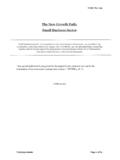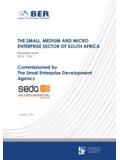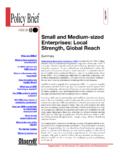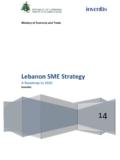Transcription of SET-ASIDES AND PREFERENCE PROGRAMS
1 183 CHAPTER 11 SET-ASIDES AND PREFERENCE PROGRAMS Because small businesses are responsible for most of the job creation and techni-cal innovations in the United States, Congress and the president have shown great in-terest in encouraging the growth and health of small businesses throughout the American economy. One of the most direct ways the government can encourage and nurture small businesses is through federal contracts. THE small BUSINESS ACT The small Business Act of 1953 states that small businesses should receive a Afair proportion@ of federal contracts and that small businesses should have the Amaximum practical opportunity@ to participate in federal contracting. The small Business Act established the small Business Administration (SBA) to aid small businesses and to insure they receive a Afair proportion@ of federal contracts.
2 Congress has established a 23% governmentwide goal for awards of contracts to small businesses . Subsets of the small business goal are a 5% governmentwide goal for awards to small disadvantaged businesses (SDBs), a 5% governmentwide goal for awards to women-owned small businesses (WOSB), a 3% governmentwide goal for awards to Ahistorically underutilized business zone@ (HUBZone) small businesses , and a 3% governmentwide goal for awards to service-disabled veteran-owned small busi-nesses (SDVOSB). A contract can get counted towards more than one goal: an award to an SDB in a HUBZone that is owned by a service-disabled woman veteran would be counted towards all the goals. Each year the SBA negotiates agency goals with each department and agency. These agency goals may be higher or lower than the governmentwide goals, depend-ing on the types of supplies and services the particular agency acquires.
3 184 Chapter 11 The SBA maintains statistics that show how successful each department and agency is in attaining its goals. It provides these statistics to Congress and the presi-dent, and disappointing statistics sometimes trigger new legislation and mandates. This is why the departments and agencies pay close attention to the number of con-tracts awarded to each targeted group of businesses . This is also the reason each con-tracting activity has at least one small and Disadvantaged Business Utilization Spe-cialist (SADBUS) to help these businesses (see Chapter 2 for more on the SADBUS and his functions). To comply with these socioeconomic policies, the government uses SET-ASIDES and PREFERENCE PROGRAMS to encourage small businesses , SDBs, HUBZone concerns, and SDVOSBs to obtain and perform government contracts.
4 small BUSINESS SET-ASIDES The small business set-aside is the most common socioeconomic program. It re-stricts, or sets aside, contracts exclusively for small business participation. Only businesses that do not exceed prescribed size standards for the supply or service being acquired are considered small and are allowed to bid or propose on small business SET-ASIDES . Bidders or offerors that exceed the applicable size standard for a particular small business set-aside are, by definition, nonresponsive and their bids or proposals will be rejected. The Rule of Two Paragraph (a) of FAR , Total small Business SET-ASIDES , states that pur-chases shall be set aside for small business unless the contracting officer determines there is not a reasonable expectation of obtaining offers from two or more responsi-ble small business concerns that are competitive in terms of market prices, quality, and delivery.
5 This requirement is commonly called the rule of two, and it applies to all purchases that exceed the micro-purchase threshold (see Chapter 8). Because of the importance each agency places on meeting its small business contract award goals, most agencies require each contracting activity s SADBUS to review all acquisitions over the simplified acquisition threshold that its contracting officers decide not to set aside. SADBUSs commonly use the Central Contractor Registration (CCR) data-base to convince contracting officers of the existence of capable small businesses (see Chapter 5 for more on the CCR). Size Standards The SBA establishes small business size standards on an industry-by-industry ba-sis. It uses the North American Industry Classification System (NAICS) codes to SET-ASIDES and PREFERENCE PROGRAMS 185 identify the various industries (NAICS codes are available at gov/epcd/ ).
6 The most prevalent size standard for manufacturing in-dustries is 500 employees, and the most prevalent size standard for service industries is $ million in average annual gross revenue over the last three fiscal years. For most industries, a company that does not exceed these size standards is consid-ered small . While a business with 500 employees or $ million in gross revenue may not seem small , the purpose of setting the size standard at these levels is to allow small businesses to grow into thriving medium businesses before losing the benefits of their small business size status. However, the usual 500 employees/$ million size standards do not apply to all industries. A company that manufactures breakfast cereal foods is considered small if it has fewer than 1,000 employees (NAICS code 311230), while a company that manufactures cookies and crackers is considered small if it has fewer than 750 em-ployees (NAICS code 311821).
7 A drycleaning plant is considered small if its average annual gross revenue for the preceding three years does not exceed $ million (NAICS code 812320), but an establishment that drycleans industrial work uniforms is considered small if its average annual receipts for the preceding three years does not exceed $ million (NAICS code 812332). The SBA sets these size standards after determining the average size of the firms in each industry and the amount of competi-tion within each industry. The small business size standards are available at The contracting officer selects the appropriate NAICS code and size standard for the sup-ply or service he intends to purchase, and he includes this information in FAR , Annual Representations and Certifications (in Section K of the Uniform Contract Format see Chapter 7). The contracting officer s selection can determine whether a company is allowed to participate in a small business set-aside.
8 For instance, if a contracting officer decides to set aside a contract for paperboard boxes, should he categorize the boxes as Setup Paperboard Boxes (NAICS code 322213), which has a size standard of 500 employ-ees, or as Folding Paperboard Boxes (NAICS code 322212), which has a size stan-dard of 750 employees? The contracting officer s decision will determine whether companies with between 500 and 750 employees will be able to participate in the set-aside. This is why the SBA allows bidders and offerors to appeal the contracting officer s decision (see paragraph (c) of FAR , Determining North American In-dustry Classification System (NAICS) Codes and Size Standards, and Chapter 17 for more on size standard appeals). If a small business submits a bid or proposal for supplies under a small business set-aside expected to exceed $25,000, but that small business is not the manufacturer of those supplies, the size standard is 500 employees regardless of the actual size standard for the supply (this is called the nonmanufacturer rule ).
9 In addition, the small business nonmanufacturer must furnish supplies produced by a small business manufacturer or producer ( a concern that, with its own forces, transforms organic or 186 Chapter 11 inorganic substances including raw materials and/or miscellaneous parts or com-ponents into the end product ), and the supplies must be manufactured or produced in the United States. However, if the SBA has determined that there are no small busi-ness manufacturers or processors in the industry, the small business nonmanufacturer may provide supplies produced by any domestic manufacturer or processor. The nonmanufacturer rule is addressed in paragraph (f) of FAR , Size Standards. A complete list of supplies for which the nonmanufacturer rule has been waived is avail-able at For more on small business size standards, see FAR Subpart Size Status Determination Each bidder or offeror provides information about its average annual gross reve-nue and employees in the Online Representations and Certifications Application (ORCA) (see Chapter 7).
10 This information, along with information obtained from the CCR, is used by SBA s computers to determine whether the bidder or offeror is a small business for the NAICS code the contracting officer identified in FAR as applying to the acquisition. However, those who question the accuracy of the in-formation the bidder or offeror entered into ORCA may file a protest with the con-tracting officer. With set-aside invitations for bids (IFBs), protestors have five work-ing days after bid opening to file their protests. With set-aside requests for proposals (RFPs), the contracting officer must notify each unsuccessful offeror of the name and address of the apparent successful offeror, and protestors have five working days from receipt of this notice to file their protests. The protest must provide detailed evi-dence supporting the allegation that the bidder or offeror is not small . The contracting officer promptly forwards the size status protest to the SBA for decision (see Chapter 17 for more on protests regarding small business status).








